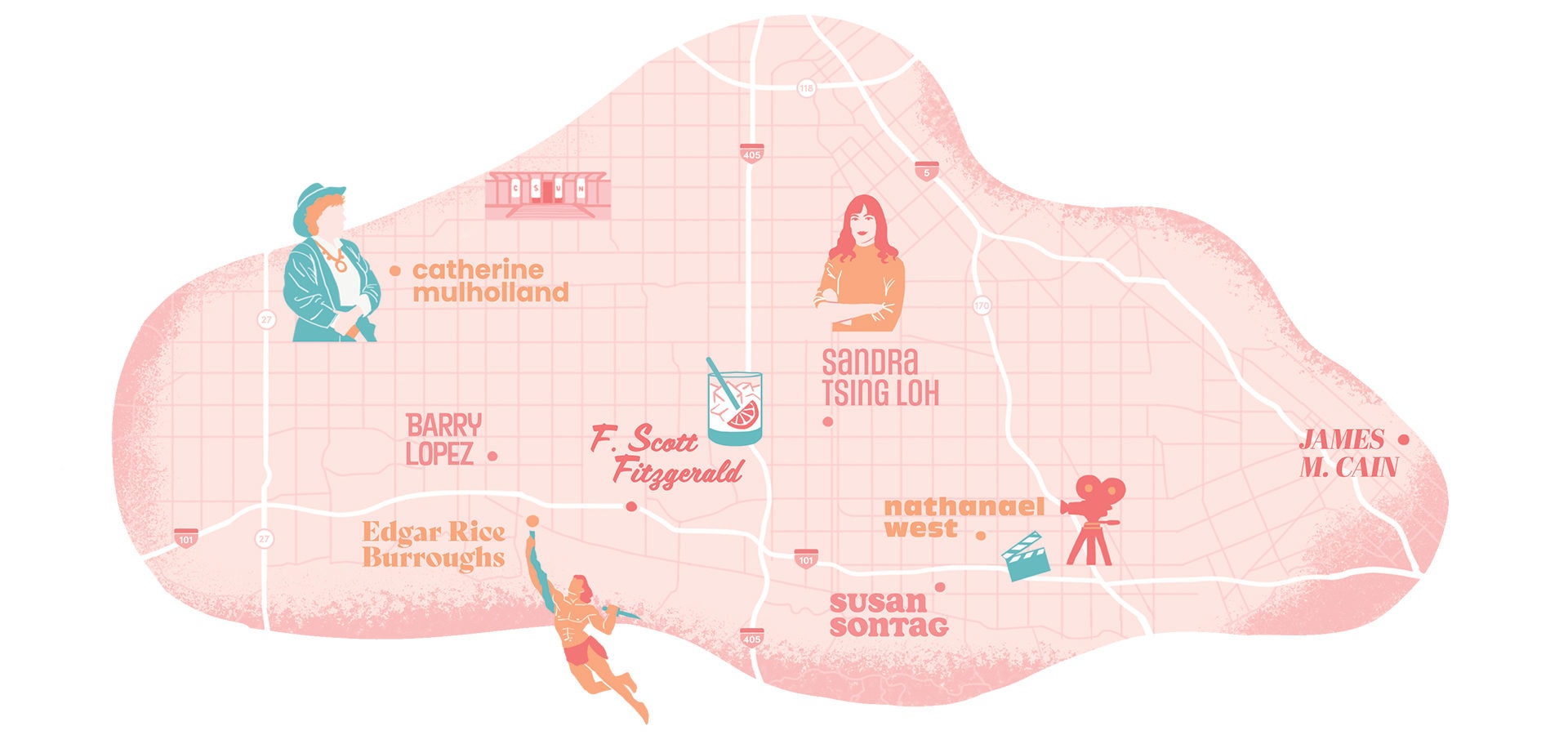
Famous Authors Who Have Called the Valley Home
A literary hub—who knew?
-
CategoryPeople
-
Written byHadley Hall Meares
-
Illustrated byNikki Smith
When we think of works that have been inspired by or made in the Valley, it’s easy to automatically go to film and TV. However, a closer inspection reveals some noteworthy ties to the literary world.
Take for example author and historian Catherine Mulholland, who wrote William Mulholland and the Rise of Los Angeles in 2000, intended to provide what she believed was a fairer view of her grandfather, who is largely credited with bringing water to southern California.
“When I think of growing up in the Valley during the 1930s, I remember solitude; the forlorn sound of a train whistle disrupting the country stillness, the howl of a coyote, the solitary jackrabbit darting across my path … as I biked to school over bumpy dirty roads,” Mulholland once wrote. In books and essays, the author would recall life on her family’s vast ranch in the West San Fernando Valley in loving detail, hearkening to the area’s Wild West origins.
An affinity for the Valley has inspired some writers to make it their own. In 1919, Edgar Rice Burroughs, the creator of Tarzan, bought Mil Flores, the former 540-acre ranch of LA Times magnate Harrison Gray Otis. Burroughs renamed the ranch Tarzana, and wrote his own song about his beloved new home:
Pine no more my lassie,
My little lad be gay!
For we’re going back
To our own Tarzana Ranch
To our own Tarzana Ranch far away.
Burroughs eventually subdivided the ranch, placing newspaper ads headlined “Tarzan of the Apes to Sell Lots in Tarzana.” And thus the town of Tarzana was born.
Other writers have found literary inspiration in the darker side of Valley life. In the early 1930s, James M. Cain moved to a small Craftsman in Burbank, where he wrote The Postman Always Rings Twice, a tale of transience and murder that starts when the protagonist meets his femme fatale at her husband’s forlorn gas station deep in the Valley. Later, in both Double Indemnity and Mildred Pierce, Cain’s striving characters find themselves stuck in the “endless suburb” of Glendale. All three of those books, by the way, were turned into films.
F. Scott Fitzgerald certainly felt stuck in 1938, when he rented a guest house at Belly Acres, the rose-and-magnolia-strewn Encino estate of actor Edward Everett Horton. Broke and feeling forgotten, a sickly Fitzgerald drank gin and worked on scripts and his famed unfinished novel, The Last Tycoon, while lying in bed.
One night in 1940, Fitzgerald dined at the North Hollywood brick farmhouse of Nathanael West, author of the grotesque Hollywood takedown The Day of The Locust. That night, Fitzgerald, Dorothy Parker and journalist Elliot Paul would reminisce about their glory days in the 1920s, ending the night with a drunken rendition of the hit song “The Last Time I Saw Paris.”
During the late 1940s, the idealized suburban family life of the Valley would stifle legendary essayist and critic Susan Sontag, a precocious student at pedestrian North Hollywood High. “I felt I was slumming, in my own life,” she recalled.
Growing up in Reseda in the 1950s, author Barry Lopez (Arctic Dreams, Of Wolves and Men; he died in December), spent hours playing on the LA River, while humorist Sandra Tsing Loh would mine her life as a Valley mom in books such as 2001’s A Year in Van Nuys.
But perhaps the loveliest lines ever written about the San Fernando Valley come from an Angeleno who never actually lived here. In Raymond Chandler’s 1942 mystery The High Window, detective Philip Marlowe notes:
“Around the curve the whole Valley spread out before me. A thousand white houses built up and down the hills, ten thousand lighted windows and the stars hanging down over them politely.”











